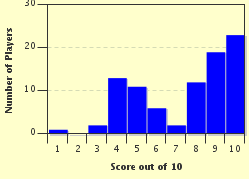Quiz Answer Key and Fun Facts
1. Considered to be the "father of his city", which wealthy banker beautified the city of Florence in the fifteenth century and established an academy for the study of Plato's works?
2. Which Dominican priest, whose sermons spoke against the "paganism" of the Renaissance, almost ended the movement in Florence?
3. Considered to be the "father of humanism", who traveled throughout Europe, searching for manuscripts that he could copy and include in his own library?
4. Whose work, "The Book of the Courtier", is often said to give one of the best descriptions of the ideal Renaissance man?
5. Considered to be the first important painter of the early Renaissance, which artist created a fresco depicting the lives of the Virgin Mary and Christ in the Scrovegni Chapel in Padua?
6. Who won a competition to sculpt bronze doors for the Baptistry, a church in Florence? The project took twenty-eight years to complete.
7. Which Italian writer wrote the "Decameron", a collection of stories set during the time of the Black Death, which ravaged Florence in 1348?
8. An early humanist, which writer wrote "Oration on the Dignity of Man", stating that God had given people free will?
9. An influential political philosopher, whose book "The Prince" proposed that the ruthless citizen-soldier was the best kind of leader?
10. Working with Nicholas of Cusa, which secretary to the pope introduced a research technique known as "textual criticism"?
Source: Author
ponycargirl
This quiz was reviewed by FunTrivia editor
bloomsby before going online.
Any errors found in FunTrivia content are routinely corrected through our feedback system.

